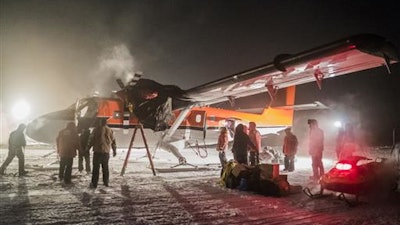
WASHINGTON (AP) — A small plane (see photos in gallery) with two sick U.S. workers left Antarctica on Wednesday in a daring rescue mission from a remote South Pole research station, officials said.
After making a stop for a few hours at a British station on the edge of Antarctica, the two workers flew to Chile, where they were expected to arrive for medical care Wednesday evening, said British Antarctic Survey spokeswoman Athena Dinar.
In a hectic two days of flying, the rescue team flew 3,000 miles roundtrip from the British station Rothera to pick up the workers at the U.S. Amundsen-Scott station at the South Pole. They arrived back at Rothera on Wednesday afternoon, said Peter West, spokesman for the National Science Foundation, which runs the U.S. station.
Then the two workers boarded a second Canadian-owned Twin Otter plane that took off for Punta Arenas in southern Chile, Dinar said.
"It's all going according to plan," said Paul Seagrove, another spokesman for the British Antarctic Survey in London, which operates the country's research station.
At Rothera, the temperature was a balmy 27.5 degrees (minus 2.5 Celsius) Wednesday afternoon. That's toasty compared to the Amundsen-Scott research station at the South Pole where it was minus 75 (minus 60 Celsius) in the morning.
The National Science Foundation hasn't identified the sick workers or their conditions, citing medical privacy. They both work for contractor Lockheed Martin. It wasn't known until Wednesday whether the second ailing worker would also be evacuated.
Before they left, there were 48 people — 39 men and nine women — at the station for the winter.
Normally planes don't go to the polar outpost from February to October because of the dangers of flying in the pitch-dark and cold. The first day of winter in the Southern Hemisphere was Monday — the sun will not rise at the South Pole till the first day of spring in September.
Steve Barnet, who works with a University of Wisconsin astronomy team at the polar station but is in the U.S. now, lauded the rescue crew.
"The courage of the pilots to make the flight in extremely harsh conditions is incredible and inspiring," Barnet wrote in an email.
The extreme cold affects a lot of things on planes, including fuel, which needs to be warmed before takeoff, batteries and hydraulics, according to West. The Twin Otter can fly in temperatures as low as minus 103 degrees (minus 75 degrees Celsius), he said.
"The air and Antarctica are unforgiving environments and punishes any slackness very hard," said Tim Stockings, operations director for the British Antarctic Survey. "If you are complacent it will bite you."
"Things can change very quickly down there" with ice from clouds, high winds and snow, he said.
There have been three emergency evacuations from the Amundsen-Scott station since 1999. The station has a doctor, a physician's assistant and is connected to doctors in the U.S. for consults, West said. But sometimes workers need medical care that can't be provided at the South Pole.
The 1999 flight, which was done in Antarctic spring with slightly better conditions, rescued the station's doctor, Jerri Nielsen, who had breast cancer and had been treating herself. Rescues were done in 2001 and 2003, both for gallbladder problems.
Scientists have had a station at the South Pole since 1956. It does astronomy, physics and environmental science with telescopes, seismographs and instruments that monitor the atmosphere. The foundation runs two other research stations in Antarctica.






















